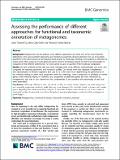Por favor, use este identificador para citar o enlazar a este item:
http://hdl.handle.net/10261/196736COMPARTIR / EXPORTAR:
 SHARE SHARE
 CORE
BASE CORE
BASE
|
|
| Visualizar otros formatos: MARC | Dublin Core | RDF | ORE | MODS | METS | DIDL | DATACITE | |

| Título: | Assessing the performance of different approaches for functional and taxonomic annotation of metagenomes |
Autor: | Tamames, Javier; Cobo-Simón, Marta; Puente-Sánchez, Fernando CSIC ORCID | Palabras clave: | Metagenomics Functional annotation Taxonomic annotation Assembly |
Fecha de publicación: | 10-dic-2019 | Editor: | BioMed Central | Citación: | BMC Genomics 20(1): 960 (2019) | Resumen: | [Background] Metagenomes can be analysed using different approaches and tools. One of the most important distinctions is the way to perform taxonomic and functional assignment, choosing between the use of assembly algorithms or the direct analysis of raw sequence reads instead by homology searching, k-mer analysys, or detection of marker genes. Many instances of each approach can be found in the literature, but to the best of our knowledge no evaluation of their different performances has been carried on, and we question if their results are comparable. [Results] We have analysed several real and mock metagenomes using different methodologies and tools, and compared the resulting taxonomic and functional profiles. Our results show that database completeness (the representation of diverse organisms and taxa in it) is the main factor determining the performance of the methods relying on direct read assignment either by homology, k-mer composition or similarity to marker genes, while methods relying on assembly and assignment of predicted genes are most influenced by metagenomic size, that in turn determines the completeness of the assembly (the percentage of read that were assembled). [Conclusions] Although differences exist, taxonomic profiles are rather similar between raw read assignment and assembly assignment methods, while they are more divergent for methods based on k-mers and marker genes. Regarding functional annotation, analysis of raw reads retrieves more functions, but it also makes a substantial number of over-predictions. Assembly methods are more advantageous as the size of the metagenome grows bigger. |
Versión del editor: | https://doi.org/10.1186/s12864-019-6289-6 | URI: | http://hdl.handle.net/10261/196736 | DOI: | 10.1186/s12864-019-6289-6 | ISSN: | 1471-2164 |
| Aparece en las colecciones: | (CNB) Artículos |
Ficheros en este ítem:
| Fichero | Descripción | Tamaño | Formato | |
|---|---|---|---|---|
| assessing_performance_approaches_functional_taxonomic_annotation_metagenomes.pdf | 4,12 MB | Adobe PDF |  Visualizar/Abrir |
CORE Recommender
PubMed Central
Citations
27
checked on 29-mar-2024
SCOPUSTM
Citations
35
checked on 16-abr-2024
WEB OF SCIENCETM
Citations
32
checked on 27-feb-2024
Page view(s)
219
checked on 18-abr-2024
Download(s)
316
checked on 18-abr-2024

